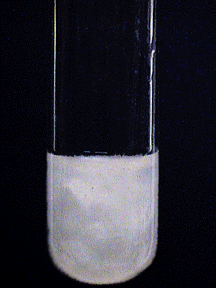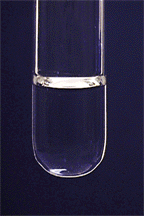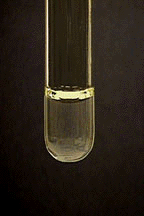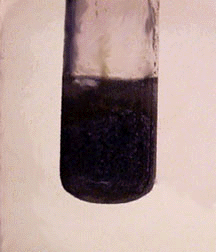
Bismuth, Bi3+
Most common oxidation states: +3, +5
M.P. 271o
B.P. 1560o
Density 9.75 g/cm3
Characteristics: Hard, brittle, with a reddish cast. Rather inactive, but will dissolve in nitric acid or hot sulfuric acid.
Characteristic reactions of Bi3+:
The +3 oxidation state is the more stable one.
Aqueous Ammonia:
Aqueous ammonia reacts with bismuth(III) ion to precipitate white bismuth hydroxide:
Bi3+(aq) + 3NH3(aq) + 3H2O(aq) <==> Bi(OH)3(s) + 3NH4+(aq)

Sodium Hydroxide:
Sodium hydroxide reacts with bismuth(III) ion to produce a precipitate of Bi(OH)3.
Bi3+(aq) + 3OH-(aq) <==> Bi(OH)3(s)

Bi(OH)3 does not dissolve in excess ammonia or sodium hydroxide, but does dissolve in acids:
Bi(OH)3(s) + 3H+(aq) <==> Bi3+(aq) + 3H2O(l)

Water:
Compounds of Bi3+ hydrolyze readily in dilute solutions, especially when chloride ion is present, to form a white precipitate of BiOCl:
Bi3+(aq) + Cl-(aq) + H2O(l) <==> BiOCl(s) + 2H+(aq)

An acid should be added to aqueous solutions of bismuth(III) salts to prevent this precipitation.
Stannite Ion:
Stannite ion reduces bismuth hydroxide to small black particles of metallic bismuth:
2Bi(OH)3(s) + 3Sn(OH)42-(aq) <==> 2Bi(s) + 3Sn(OH)62-(aq)

The solution of stannite ion must be prepared just prior to use, by treating a solution of tin(II) chloride with excess sodium hydroxide:
Sn2+(aq) + 2OH-(aq) <==> Sn(OH)2(s) (white)
Sn(OH)2(s) + 2OH-(aq) <==> Sn(OH)42-(aq)
No Reaction:
Cl-, SO42-